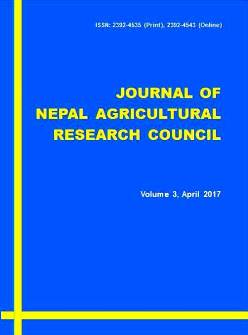Performance of Garden Pea Genotypes in Eastern Hills of Nepal
DOI:
https://doi.org/10.3126/jnarc.v3i1.17270Keywords:
Arkel, garden pea, genotypes, pod, responseAbstract
Garden pea (Pisum sativum L) is an important winter legume used as fresh vegetables and other drier food products. Despite of its importance as cash crop in many parts of Nepal, much study on various aspects for enhancing production and productivity has yet to be done. Therefore, to evaluate the production performance different genotypes of garden pea in eastern hills agro-ecological conditions present experiments were carried out consecutively for two years (2015 and 2016) at Agricultural Research Station, Pakhribas. The experiment comprised of 11 different genotypes of garden pea including a check variety Arkel. The production performance was evaluated in a completely randomized block design with three replications. The seeds were sown at 50 × 10 cm spacing during first week of October for two years. The result showed that DGP-05 genotype had earliest 104 days after sowing. The DGP-08 genotype showed 13 which were the maximum numbers of pods per plant (13), while DGP-01 showed 8 numbers of seeds as the maximum per pod. The DGP-03 genotype had the longest pod of 9.78 cm among others. The highest fresh pod yield of 18.14 t/ha was achieved from genotype DGP-09 followed by Arkel with (16.32 t/ha).
Journal of Nepal Agricultural Research Council Vol.3 2017: 15-18




